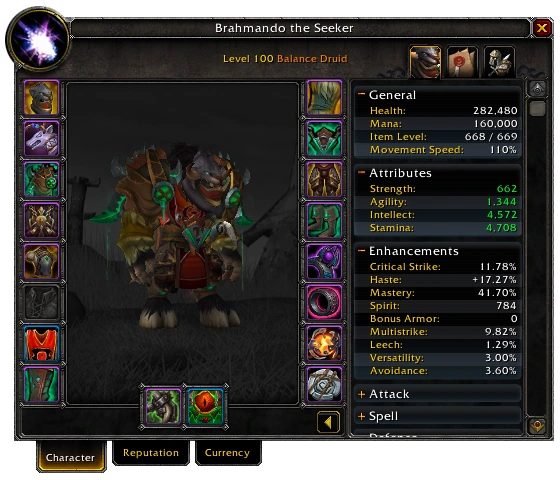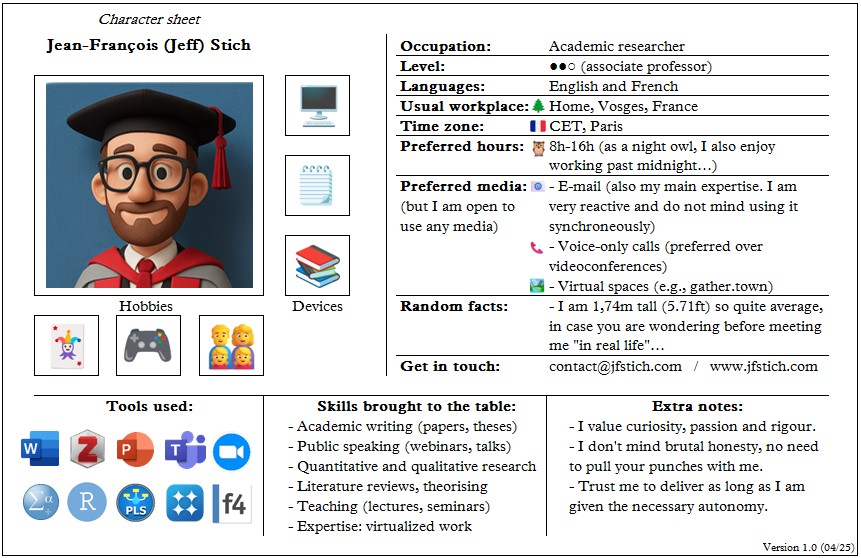Starter packs, character sheets and virtual work
A recent trend on social media is to share an AI-generated image of oneself depicted as an action figure in a blister with one’s favourite items – a “starter pack”. I wanted to take a moment to reflect on this fun and harmless trend, and put it back in the wider context of working virtually with one another.

Your personal “blueprint” in the virtual world
The idea of sharing a bit of oneself with others to facilitate collaboration is not new. Experts on virtual work have discussed for over a decade the idea of writing and sharing your personal “user manual” that others could read to know what to expect when they collaborate with you. This practice has been referred to with diverse names such as personal “user manual”, “readme” or “blueprint”.
The idea of such blueprint is to display in one document many information that others would need or like to know before working with you. Examples of such information include:
- Where do you work and when (in what time zone, during which working hours);
- What are your preferred communication media;
- Personal and professional values, preferences, fun facts or important information to know.
Many examples of personal blueprints can be found online, and several are compiled in Lisette Sutherland’s own “user manual” (along with a guide on how to write one).
In comparison, the AI-generated “starter pack” is quite simplistic and rather superficial, but could be a nice and fun way to illustrate your blueprint – as it does with this article. A picture is worth a thousand words, and who reads user manuals anyway?
Research on virtual communication styles and norms
Academic studies have not researched personal user manuals, as far as I know. Of course, there are thousands of articles on CVs and résumés, which share many similarities with personal blueprints to some extent. CVs also present skills, experiences and a certain idea about what to expect from a collaboration with the CV’s owner. However, CVs are targeted at employers, whereas blueprints are targets at fellow colleagues. They also serve different purposes.
Academic studies did research the importance of knowing each other in order to efficiently collaborate in the “virtual world” of work. In my own research for instance, I have found that stress increases when one’s actual use of communication media is not aligned with one’s preferred use. E-mails can be stressful both in excess and in deficit of one’s preferences (Stich et al., 2019). While some employees enjoy long and vivid synchronous phone calls, others prefer short asynchronous e-mails and get stressed and anxious when their phone rings (Stich et al., 2017).
When people do not know which medium to use to initiate a conversation, they often fall back to e-mails. This practice of using “e-mail by default” can be detrimental and cause overload when, at the end of the day, e-mail was not the most appropriate and most preferred medium to use after all (Tarafdar et al., 2023).
It is thus crucial to develop a form of empathy towards each other’s preferences and habits when interacting with them virtually. The power often lies in the hands of the person initiating the communication, and this person is each of us.
Intriguing parallels with virtual worlds and online games
The “starter pack” trend and the suggestions to write personal blueprints are intriguingly close to a feature present in many roleplaying games (video games or tabletop ones): the character sheet.
As you may know, I am a bit of a gamer myself and I was lucky to work in the videogame industry for a few years too, mainly researching players’ behaviours in online games (see, for instance, my article analysing the psychology of the Sims video game).
One study had a profound impact on me and brought me down my career path as an academic. This report entitled “Virtual Worlds, Real Leaders” by Byron Reeves (Stanford professor) studied the ways through which leadership is enabled and enacted in the virtual worlds of massively multiplayer role-playing games (MMORPGs) (Reeves & Malone, 2007). In these games, leaders are facilitating the collaboration between people who do not know and have never seen each other “in real life”.
A central “managerial” tool in this virtual leadership is the “character sheet” that depicts, in one single tab, all the information about your character’s strength, weaknesses, achievements, skills and equipment. This character sheet provides total transparency on “who” your character is and what he or she can accomplish in the game. Collaboration between players (and their characters) is much facilitated by this transparency, as studied in the Reeves & Malone (2007) report.

A character sheet in World of Warcraft.
I continue to think that virtual work has much still to learn from other, non-work virtual worlds. This idea of a character sheet, akin to the personal blueprint of virtualized workers, is one such example. In fact, this idea will be present in a project I am working on at the moment and that I will share when the time is right – stay tuned!
My personal character sheet
Would this idea really be convincing if I did not even try to apply it to myself? Just like I wrote a draft charter for the “right to disconnect” as an illustration to my review on the stress of hyperconnectivity, allow me to draft and share my own personal character sheet or blueprint.

References
- Stich, J.-F., Tarafdar, M., Cooper, C. L., & Stacey, P. (2017). Workplace stress from actual and desired computer-mediated communication use: A multi-method study. New Technology, Work and Employment, 32(1), 84–100.
- Stich, J.-F., Tarafdar, M., Stacey, P., & Cooper, C. L. (2019). E-mail load, workload stress and desired e-mail load: A cybernetic approach. Information Technology & People, 32(2), 430–452.
- Tarafdar, M., Wenninger, H., & Stich, J.-F. (2023). Email Overload: Investigating Technology-fit Antecedents and Job-related Outcomes. The Data Base for Advances in Information Systems, 54(2), 77–96. Reeves, B., & Malone, T. (2007). Leadership in Games and at Work: Implications for the Enterprise of Massively Multiplayer Online Role-playing Games. IBM.
